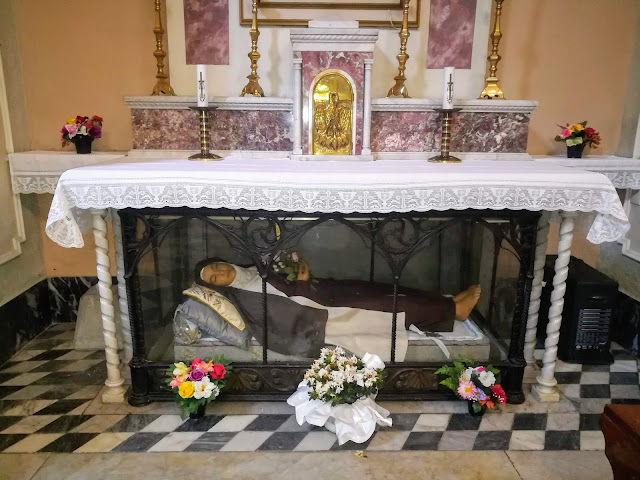Recently we heard from an old friend, C., who turns out to be living in the hills above Pontremoli. None of us has a car, but if we were willing to take a train to Pontremoli, she said, she could take an early-morning bus down to the town and meet us there for lunch. Now we had two reasons to make a day trip there, and so we went, bringing Pam along with us.
Pontremoli is a medieval town about an hour from Fidenza, on the northeastern edge of Tuscany. It takes its name from a "trembling bridge" across the Magra River. Magra means skinny or slender, and the river certainly doesn't look like much in the summer.
But C. tells us that the winter rains swell the river to the point where it regularly floods the low-lying parts of town and forces the evacuation of many residents. At least the bridge is now a sturdy stone one that doesn't tremble at all.
Pontremoli seems considerably less modernized than our town. There are plenty of beautiful old palazzi but the streets are dark and narrow. Our friend says that many houses are still heated with wood. (Hers has a more up-to-date pellet stove.) One household was chopping up fuel for next winter as we went by.
It was too early in the season for chestnuts or mushrooms, but Danny was eager to try testaroli, another local specialty--large wheat-and-water crepes that are eaten with pesto or olive oil. We had some at lunch, an experience I don't feel we need to ever repeat. The testarolo was flabby and flavorless, even slathered with pesto--and both C. and Pam assured us that this was evidence not of the restaurant's incompetence, but its authenticity.
Testaroli are sometimes called the earliest form of pasta, and it does seem primitive compared to tagliatelle or spaghetti, both in texture and taste. Some people love them, though I have a hard time imagining why. I've even noticed vacuum-packed testaroli for sale in the wonderful cheese and salumi shop downstairs from us, looking like large brown plastic place mats.
Speaking of primitive, we also visited one of Pontremoli's main attractions, the Museo Statue Stele, a collection of Bronze Age sculptures believed to be divinities or totems carved by people who lived in the area five thousand years ago. The carvings were unearthed relatively recently, and the details of who these people were and what these stelae meant to them remain mysterious.
The collection is small but the museum has wisely made it extremely photogenic.
The earliest specimens have no necks.
Later versions have shield-like heads. Throughout, the male figures are distinguished by daggers held at crotch level, the females by prominent breasts.
The collection is housed in an 11th-century castle on a hill overlooking the town. It's called Castello del Piagnaro, named after the piagne, the sandstone slabs used to cover the roof, which seems like a very casual style of shingling, but evidently a durable one.
After admiring the stelae we wandered around the castle, which was mostly empty. When I looked in one open door, though, I found myself staring at a darkened room full of bunk beds which were in turn full of scantily clad men, who laughed as I scurried away. I can't imagine what they were doing there. Pontremoli is on the Via Francigena, so perhaps they were pilgrims resting up before pushing on to Fidenza. Or maybe, like so many Pontremolians in days of yore, they were seeking sanctuary inside the castle walls.
From the castle ramparts we could see the town and the dome of its cathedral. Which we stopped into on our way back to the train. It's an adorable baroque candy box......with a black Jesus...
...and a mummified nun.
I couldn't find any information in the cathedral or on line explaining any of this. By then it was becoming clear that this was a day of mysteries.
While in the cathedral I was struck by how much the escutcheons you see all over Catholic churches, gazing down at us from above altars and doorways, look like those little Bronze Age divinities.
Could there be a connection? Is there any way to know?
After a late afternoon gelato we said good-bye to C. and headed back to the train station and home.
Our stomachs were happy, but my head at least was heavy with unanswered questions.














2 comments:
Hi Tessa, I have not read everything yet but nice to finally get the feel of your life in Italia through your blog. I do think that the sculptures in your latest post are definitely evidence that Italy was visited by extraterrestrials in the past.
And your apartment remodel is lovely.
Hope the heat subsides soon. I look forward to reading more posts. All the best, Annetta
It sounds like you stumbled into the opening chapter of the next Dan Brown novel.
HH
Post a Comment